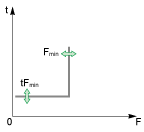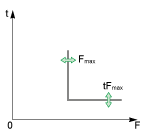Under/Overfrequency Protection (ANSI 81)
The frequency in electrical installations must be maintained within accepted operating levels to minimize the risk of damage to motor loads, sensitive electronics, and to ensure the proper operation and performance of all loads.
There are two independent protections:
oUnderfrequency (ANSI 81U)
oOverfrequency (ANSI 81O)
Under/overfrequency protection constantly monitors the frequency. If the frequency of an installation exceeds its acceptable limits, the information delivered by the under/overfrequency protection can be used to initiate appropriate action to restore good operating conditions in the installation. The under/overfrequency protection is used to generate either an alarm or a trip, when required.
Under/overfrequency protection is suitable for generator use. The continuous monitoring of frequency enables appropriate action to be initiated to safeguard the operation of the installation during abnormal or critical situations, for example, load shedding, source change-over, and emergency generator starting.
Under/overfrequency protection is available when the ANSI 81 - Under/Overfrequency Digital Module is purchased and installed on a MicroLogic X control unit.
Under/overfrequency protection requires an external 24 Vdc power supply.
Under/overfrequency protection is compatible with:
oMicroLogic 2.0 X, 5.0 X, 6.0 X, and 7.0 X control units for IEC standard
oMicroLogic 3.0 X, 5.0 X, and 6.0 X control units for UL standard
oMicroLogic X control units with firmware version greater than or equal to 003.012.000. Earlier firmware versions need to be updated.
Data from the Digital Module is available remotely through IFE/EIFE or IFM communication interfaces, if the IFE/EIFE or IFM firmware version is compatible with the Digital Module. For more information, refer to firmware compatibility of the communication interfaces.
Operating Principle of Underfrequency Protection (ANSI 81U)

|
Underfrequency protection monitors the frequency. When the system frequency reaches the threshold Fmin, the protection picks up and the time delay tFmin starts. The frequency is calculated from V12 phase-to-phase voltage. Underfrequency protection has the following characteristics: oIs inhibited when V12 is lower than 20 Vac. oOperates with a definite time characteristic. oCan be disabled. The protection trips if both the following conditions are met: oThe frequency is lower than Fmin. oThe time delay tFmin is elapsed. |
Operating Principle of Overfrequency Protection (ANSI 81O)

|
Overfrequency protection monitors the frequency. When the system frequency reaches the threshold Fmax, the protection picks up and the time delay tFmax starts. The frequency is calculated from V12 phase-to-phase voltage. Overfrequency protection has the following characteristics: oIs inhibited when V12 is lower than 20 Vac. oOperates with a definite time characteristic. oCan be disabled. The protection trips if both the following conditions are met: oThe frequency is greater than Fmax. oThe time delay tFmax is elapsed. |
To inhibit the underfrequency (ANSI 81U) or overfrequency (ANSI 81O) protections, both the following conditions must be met:
oInhibition is enabled by setting the Inhibition parameter to ON. Inhibition is enabled independently on each protection (ANSI 81U or ANSI 81O).
oInhibition of optional protections is activated by an input of the IO module. The function Inhibit Optional Protection must be assigned to an input of the IO module.
For more information about inhibiting optional protections, refer to Enerlin'X IO - Input/Output Application Module for One Circuit Breaker - User Guide.
NOTE: The underfrequency (ANSI 81U) and overfrequency protections (ANSI 81O) can be inhibited separately, or together.
Setting Underfrequency Protection
The settings for underfrequency protection are:
oFmin mode: enables (ON) or disables (OFF) underfrequency protection
oFmin action: sets the result of underfrequency protection activation as trip or alarm
oTrip: the circuit breaker trips and three events are generated (start, operate, and trip)
oAlarm: two events are generated (start and operate)
oFmin inhib: enables (ON) the protection to be inhibited by IO module
oFmin: underfrequency protection threshold
otFmin: underfrequency protection time delay
They can be set as follows:
oWith EcoStruxure Power Commission software (password-protected)
oWith EcoStruxure Power Device app (password-protected)
The dual settings function does not apply to underfrequency protection. When the dual settings function is enabled, underfrequency protection settings are the same whether set A or set B settings are activated.
Underfrequency Protection Settings
|
Settings |
Unit |
Setting range |
Step |
Factory settings |
Accuracy |
|---|---|---|---|---|---|
|
Fmin mode |
– |
ON/OFF |
– |
OFF |
– |
|
Fmin action |
– |
Alarm/Trip |
– |
Alarm |
– |
|
Fmin inhib |
– |
ON/OFF |
– |
OFF |
– |
|
Fmin |
Hz |
40–65 |
0.1 |
48 |
o±0.01 Hz for V12 > 100 V o±0.05 Hz for 20 V < V12 < 100 V(1) |
|
tFmin |
s |
0–300 |
0.05 |
1 |
±2%, ±20 ms |
|
(1) Stability on sudden voltage change (phase and magnitude shift) according to IEC 60255-181 Stability on voltage with harmonics (with disturbed zero crossing) according to IEC 60255-181 |
|||||
NOTE: Frequency protections are inhibited when V12 is lower than 20 Vac.
Underfrequency Protection Characteristics
oDefinite time delay
oInstantaneous reset time
oHysteresis: fixed 1.0002
oMinimum breaking time: 50 ms
oMaximum breaking time (with time delay set to 0 s):
o140 ms for frequency ramps from 0.5 Hz/s to 5 Hz/s according to IEC 60255-181
o140 ms in case of sudden frequency change according to IEC 60255-181 for settings between 48 and 52 for 50 Hz application and 58 to 62 for 60 Hz application
o200 ms in case of sudden frequency change according to IEC 60255-181 for settings between 45 and 55 for 50 Hz application and 55 to 65 for 60 Hz application
Setting Overfrequency Protection
The settings for overfrequency protection are:
oFmax mode: enables (ON) or disables (OFF) overfrequency protection on one phase
oFmax action: sets the result of overfrequency protection activation as trip or alarm
oTrip: the circuit breaker trips and three events are generated (start, operate, and trip)
oAlarm: two events are generated (start and operate)
oFmax inhib: enables (ON) the protection to be inhibited by IO module
oFmax: overfrequency protection threshold
otFmax: overfrequency protection time delay
They can be set as follows:
oWith EcoStruxure Power Commission software (password-protected)
oWith EcoStruxure Power Device app (password-protected)
The dual settings function does not apply to overfrequency protection. When the dual settings function is enabled, overfrequency protection settings are the same whether set A or set B settings are activated.
Overfrequency Protection Settings
|
Settings |
Unit |
Setting range |
Step |
Factory settings |
Accuracy |
|---|---|---|---|---|---|
|
Fmax mode |
– |
ON/OFF |
– |
OFF |
– |
|
Fmax action |
– |
Alarm/Trip |
– |
Alarm |
– |
|
Fmax inhib |
– |
ON/OFF |
– |
OFF |
– |
|
Fmax |
Hz |
45–70 |
0.1 |
62 |
o±0.01 Hz for V12 >100 V o±0.05 Hz for 20 V<V12<100 V(1) |
|
tFmax |
s |
0–300 |
0.05 |
1 |
±2%, ±20 ms |
|
(1) Stability on sudden voltage change (phase and magnitude shift) according to IEC 60255-181 Stability on voltage with harmonics (with disturbed zero crossing) according to IEC 60255-181 |
|||||
NOTE: Frequency protections are inhibited when VLL is lower than 20 Vac.
Overfrequency Protection Characteristics
oDefinite time delay
oInstantaneous reset time
oHysteresis: fixed 0.9998
oMinimum breaking time: 50 ms
oMaximum breaking time (with time delay set to 0 s):
o140 ms for frequency ramps from 0.5 Hz/s to 5 Hz/s according to IEC 60255-181
o140 ms in case of sudden frequency change according to IEC 60255-181 for settings between 48 and 52 for 50 Hz application and 58 to 62 for 60 Hz application
o200 ms in case of sudden frequency change according to IEC 60255-181 for settings between 45 and 55 for 50 Hz application and 55 to 65 for 60 Hz application
The function generates the following predefined events:
|
Code |
Event |
History |
Severity |
|---|---|---|---|
|
0x6415 (25621) |
Underfrequency trip |
Trip |
High |
|
0x6416 (25622) |
Overfrequency trip |
Trip |
High |
|
0x6215 (25109) |
Underfrequency start |
Protection |
Low |
|
0x6216 (25110) |
Overfrequency start |
Protection |
Low |
|
0x6315 (25365 |
Underfrequency operate |
Protection |
Medium |
|
0x6316 (25366) |
Overfrequency operate |
Protection |
Medium |
|
0x0EF8 (3832) |
Optional protection inhibited by IO module |
Protection |
Low |
|
0x0D0C (3340) |
Config error IO/CU: optional protection Inhibit |
Configuration |
Medium |
Predefined events cannot be modified by the user. For general information about events, refer to Event management.
Protection events are generated as follows:
oThe start event is generated when the protection picks up.
oThe operate event is generated when the protection time delay elapses.
The operate event is not generated when the optional protection is inhibited.
oThe trip event is generated when the circuit breaker tripping voltage release (MITOP) activates.
The trip event is not generated when:
oThe optional protection is set in alarm mode
oThe optional protection is inhibited
|
Code |
Event |
Recommended actions |
|---|---|---|
|
0x6415 (25621) |
Underfrequency trip |
Reset the device or use the Power restoration assistant within the EcoStruxure Power Device app. |
|
0x6416 (25622) |
Overfrequency trip |
Reset the device or use the Power restoration assistant within the EcoStruxure Power Device app. |
|
0x0EF8 (3832) |
Optional protection inhibited by IO module |
Check inhibition selector switch wired with IO module. |
|
0x0D0C (3340) |
Config error IO/CU: optional protection Inhibit |
Correct the configuration error with EcoStruxure Power Commission software: oIf you want optional protection inhibition to be controlled by IO module, connect an IO module with inhibit optional protection assignment. oIf you do not want optional protection inhibition to be controlled by IO module, connect an IO module without inhibit optional protection assignment. |
For information about resetting the circuit breaker after a trip due to an electrical fault, refer to the relevant document:
oMasterPact MTZ1 - Circuit Breakers and Switch-Disconnectors - User Guide
oMasterPact MTZ2/MTZ3 - Circuit Breakers and Switch-Disconnectors - User Guide